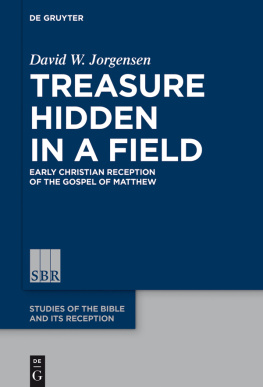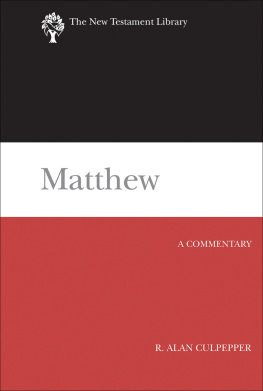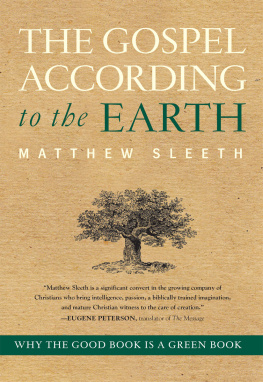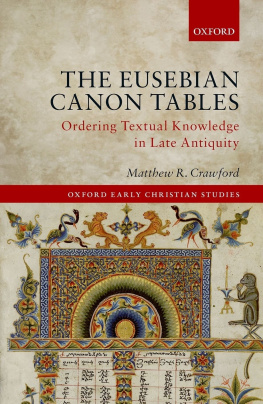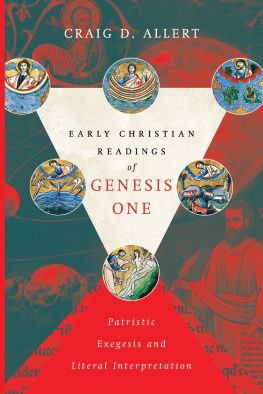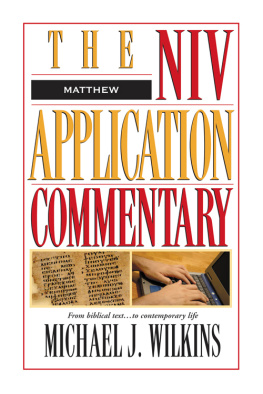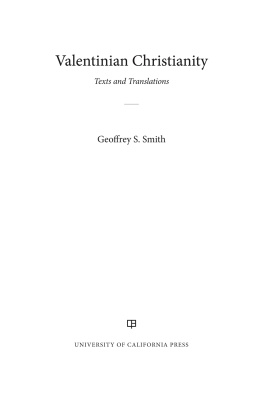Treasure Hidden in a Field
Guide

David W. Jorgensen
Treasure Hidden in a Field
Studies of the Bible and Its Reception

Edited by
Dale C. Allison, Jr., Christine Helmer,
Thomas Rmer, Choon-Leong Seow,
Barry Dov Walfish, Eric Ziolkowski
Volume 6

Winner of the 2015 SBL De Gruyter Prize for Biblical Studies and Reception History
ISBN 978-3-11-047655-2
e-ISBN (PDF) 978-3-11-047808-2
e-ISBN (EPUB) 978-3-11-047660-6
ISSN 2195-450X
Library of Congress Cataloging-in-Publication Data
A CIP catalog record for this book has been applied for at the Library of Congress.
Bibliographic information published by the Deutsche Nationalbibliothek
The Deutsche Nationalbibliothek lists this publication in the Deutsche Nationalbibliografie;detailed bibliographic data are available in the Internet at http://dnb.dnb.de.
2016 Walter de Gruyter GmbH, Berlin/Boston
Logo: Martin Zech
www.degruyter.com

The kingdom of heaven is like treasure hidden in a field, which someone discovered and hid; then in his joy he goes and sells all he has and buys that field.
~ Matthew 13.44
Christ is the treasure that was hidden in the field the treasure hidden in the Scriptures was Christ, since he was indicated by types and parables.
~ Irenaeus, Adversus Haereses 4.26.1
Inventio is the discovery of valid or seemingly valid arguments to render ones cause plausible.
~ Cicero, De inventione 1.7.9
Preface
This project would not have come to its completion without the help of numerous individuals, and it is my pleasure to express my gratitude to them in these pages.
As this book is a revision of my dissertation (2014, Princeton University), I would first like to thank my advisor, Elaine Pagels, and my two readers, Anne-Marie Luijendijk and Martha Himmelfarb, each of whom gave my work careful attention. Professor Pagels work was an early influence on my returning to the academic study of religion, and I learned a great deal from her about the ancient sources, the nature of scholarship, and the iterative writing process. She constantly forced me to make my research more focused and my writing more clear, and ideas generated in her lively seminars pervade this project. Professor Luijendijk likewise taught me a great deal about the craft of academic research and writing. She helped me to better see how to place my work in conversation with various fields of study, and in my writing she consistently urged me to move my lamp from underneath the bushel basket and onto the lampstand. Her enthusiasm for research and teaching, and her essential optimism, continue to be inspirational. I learned a great deal from Professor Himmelfarb about performing close, careful readings of ancient texts. I am grateful for her deep knowledge of institutional processes, and she consistently taught me to worry about things in proper measure to their significance. Altogether I benefited enormously from their diverse perspectives and concerns. I must also thank Moulie Vidas, Naphtali Meshel, John Gager, and Wallace Best for their support, feedback, and encouragement. I will be forever grateful to Jeffrey Stout for his wise counsel, good shepherding, and mentorship in manifold capacities.
At Princeton, I was fortunate to have Philippa Townsend, Eduard Iricinschi, Lance Jenott, Geoffrey Smith, Alexander Kocar, Gregg Gardner, Sarit Kattan Gribetz, Mika Ahuvia, David Grossberg, Abraham J. Berkowitz, Eva Kiesele, Thomas Carlson, Nicholas Marinides, and Jack Tannous as colleagues and interlocutors with penetrating knowledge of the world of late antiquity. The Center for Hellenic Studies was one of my homes at Princeton, and I am thankful for the friendship and philoxenia of Dimitri Gondicas and Carol Oberto. The Stanley J. Seeger Hellenic Fund supported, in part, my doctoral studies, as did the Center for the Study of Religion, which also provided me with palatial office space for my last two years of graduate school. My discussion partners in the CSR Religion and Culture Workshop provided sophisticated and perceptive feedback on some of the chapters. The Unitarian Universalist Associations Panel on Theological Education supported me with a generous dissertation completion grant exactly when it was needed the most. After moving to Maine, a research grant from the North American Patristics Society provided needed financial support while I revised the book manuscript.
Previous teachers deserve special mention for planting seeds which, after a long period of growth, would eventually bear fruit. These include Jamshed Barucha, Alan Gaylord, Jeremy Rutter, and Neal Walls at Dartmouth College; Franois Bovon, Sarah Coakley, Eldon Epp, Karen King, Helmut Koester, David Lamberth, Peter Machinist, and Laura Nasrallah at Harvard Divinity School; and Rev. Thomas Mikelson.
I undertook the revision of the dissertation manuscript into a book as a research associate at Colby College, and I am most grateful to Lori Kletzer for this appointment. In the Department of Religious Studies, Debra Campbell, David Freidenreich, Carleen Mandolfo, Nikky Singh, and Julie Parker have been exceptionally warm, supportive, and hospitable colleagues, as has Rabbi Rachel Isaacs in Jewish Studies. Suzanne Jones and Marilyn Pukkila helped me get my bearings and navigate the Colby waters. Innumerable members of the Colby community have gone out of their way to help Waterville feel like home. My students in my course Religious Diversity in the Ancient Mediterranean, which I taught both at Colby and at the University of Maine Farmington Honors Program, pleasantly forced me to articulate many of the ideas in this book with greater clarity. It has been a sheer pleasure to learn an enormous amount about biblical exegesis, from my students at the Maine School of Ministry and Meadville Lombard Theological School, under the guise of teaching them the same.
I am eternally grateful to Bruce Beck, the director of the Pappas Patristic Institute at Holy Cross Greek Orthodox School of Theology and my teacher and mentor during five summer Institutes there, for his charity and good humor, for helping me to more fully appreciate Irenaeus of Lyons, and to better comprehend patristic hermeneutics. was born at my first summer Institute, and since then I have been able to refine my thinking on every chapter in this book by teaching classes there on Second Century Christianity and on The Theology and Hermeneutics of Irenaeus of Lyons, a course which one student dubbed A Refutation and Overthrow of Irenaeus Against the So-Called Heresies . I would like to thank all of my teachers, students, and colleagues there, especially Brian Matz, George Tsakiridis, Maria Doerfler, Robert Assaly, and Bishoy Dawood. I am especially grateful to my teaching fellows for my class on Irenaeus who thoroughly engaged with and challenged my heterodox ideas: Ben Safranski, Don Springer, and Charles J. Schmidt.
I have presented portions of this book to engaging and charitable audiences at the Society of Biblical Literature, the American Academy of Religion, the Philadelphia Seminar on Christian Origins, the Rome International Conference on . Aryeh Amihay has read multiple drafts of the Introduction and Conclusion, is a meticulous proofreader, and has offered countless thoughtful and perceptive suggestions on these chapters and on the writing process as a whole. Special thanks go to Ismo Dunderberg, Christoph Markschies and Einar Thomassen, who have given encouragement and suggestions on numerous occasions; my indebtedness to their scholarship may be easily discerned in these pages.

